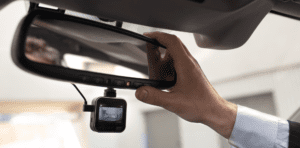Compare cheap car insurance
✔ Compare cheap car insurance quotes
✔ Over 110 insurance providers
✔ Get a quote in minutes
✔ Save up to £504*
Getting on the motorway for the first time can seem intimidating. But with the right preparation, it doesn’t have to be scary.
Our helpful guide outlines everything you need to know before hitting the fast lane, from motorway driving rules to tips for staying safe and calm on your journey.
- How to drive on the motorway
- 9 tips for driving on the motorway
- How to safely join and leave the motorway
- How to be a more confident motorway driver
- How to get additional driving experience
- The rules of the motorway
- How to drive on a smart motorway
- Frequently asked questions
We’ll cover how to properly enter and exit the motorway, lane discipline, speed limits, what to do in case of breakdowns or accidents, and more.
By the end, you’ll feel equipped and reassured for your first time driving on the motorway. With this starter guide, you can be a confident and savvy motorway driver.
How to drive on the motorway
Transitioning to motorway driving can seem intimidating at first. But with the right knowledge, your first time on the multi-lane highway doesn’t have to be nerve-wracking.
While motorways share basic rules of the road, there are some key differences to understand. We’ll walk you through how to properly enter, choose lanes, maintain speed, pass safely, and exit. You’ll learn motorway-specific etiquette and regulations so you can drive with confidence.


We’ll also provide tips to make your motorway journey smooth, covering topics like checking mirrors, signalling properly, watching for hazards, and managing faster speeds. You’ll get actionable advice for dealing with breakdowns, accidents, or other emergencies should they arise.
By the end of this guide, you’ll have all the must-knows for driving the motorway safely. You’ll feel equipped to handle these faster roads and be a savvy, assured motorway driver.
So read on for the essential information you need to prepare for your first motorway trip! With the right mindset and skills, your motorway driving debut doesn’t have to be daunting.
How much can you save on your car insurance?
9 tips for driving on the motorway


Prepare Your Car
Before you start your journey, conduct a comprehensive check of your car. Ensure that lights, tyre pressures, oil levels, brake fluid, and screen wash are all at optimal levels. For detailed steps on long journey preparation, refer to our inclusive car safety checklist.
Plan Your Route
Memorise the junction numbers where you will enter and exit the motorway. This foresight allows you to position yourself in the appropriate lane well in advance of your exit, mitigating last-minute lane changes. Although satnavs are invaluable, they aren’t infallible, so having a mental roadmap is important.
Learn Your Motorway Signs
Familiarise yourself with motorway signs and signals. Understanding these indicators will reduce confusion and hesitation while driving, promoting a smoother and safer ride.
Remember, signs positioned on the central reservation apply to all lanes. For insight into smart motorway signs, refer to our specific guide below.
Stick to the Left Lane
The concept of a ‘fast lane’ is a misconception. Always use the left lane, or lane one, for regular driving, reserving the other lanes for overtaking or accommodating emergency vehicles. Upon completing an overtake, promptly return to the left lane.
Avoid Distractions
Driving requires your undivided attention. Eliminate distractions such as mobile phones, overly engaging conversations with passengers, or fiddling with the radio. Focused driving is safe driving.
Check Your Mirrors
Maintain constant awareness of your surroundings. Vehicles might approach faster than you anticipate, hence regularly check your mirrors, signal in advance, and always perform a shoulder check to identify potential blind spots before lane changes.
Don’t Tailgate
Following too closely behind another vehicle is hazardous. Use the two-second rule as a guideline for safe distance, though consider extending this gap to at least three seconds when driving at the 70mph national speed limit due to the increased stopping distance required at higher speeds.
Take a Break
The Royal Society for the Prevention of Accidents (ROSPA) suggests that fatigue contributes to up to 20% of UK road accidents, with motorways being particularly high-risk due to their long, often monotonous stretches. Take regular breaks—every two hours or whenever tiredness strikes. A brief stop for refreshments can rejuvenate you, but if fatigue persists, refrain from continuing your journey until you are rested.
Adjust Your Speed on the Slip Road
Slip roads facilitate a smooth transition onto and off the motorway. When entering, accelerate to align with the speed of the traffic in the left-hand lane. Conversely, as you prepare to exit, decelerate appropriately on the slip road to seamlessly integrate into the speed of the exiting traffic.
How much can you save on your car insurance?
How to safely join and leave the motorway
Joining and leaving the motorway can often seem daunting, especially if you’re a new driver.
The process requires a keen understanding of speed adjustment and strategic planning to seamlessly merge with the flow of high-speed traffic, ensuring not just your safety but also that of other motorists.
Joining the Motorway:
Speed Adjustment on Slip Roads: The initial step in joining a motorway is entering via a slip road. Here, you must adeptly adjust your speed to match the ongoing traffic on the motorway. Typically, this involves accelerating to seamlessly merge with the speed of other vehicles, but deceleration may also be necessary in the event of congestion or a traffic jam.
Anticipating Traffic Flow: Develop a keen sense of anticipation for the actions and speeds of other drivers. Look ahead, gauge the flow of traffic, and adjust your speed accordingly to prevent sudden braking or complete stops, which can be hazardous.
Safe Merging Practices: When merging, identify a safe gap between vehicles and smoothly integrate into the traffic. Be mindful of the fact that motorway traffic has the right of way. Always use your indicators to signal your intentions to other drivers and conduct a quick but thorough check of your blind spot to ensure it’s safe to merge.
Leaving the Motorway:
Early Lane Positioning: As you approach your exit, prepare by positioning your vehicle in the correct lane well in advance. This practice prevents last-minute, potentially dangerous lane changes and cutting across lanes of traffic, enhancing your safety and that of others.
Understanding Exit Signs: Exits on motorways are clearly signposted. Pay attention to countdown markers that indicate the proximity of the exit, with each bar typically representing 100 yards. These signs provide crucial information that aids in timing your exit precisely and safely.
Smooth Exit Protocol: Once you are nearing the exit, use your indicators early to alert other drivers of your intention to leave the motorway. Avoid sudden braking while still on the main carriageway; instead, start decelerating once you have entered the exit slip road. This practice ensures a smoother transition from the high-speed motorway environment to the slower speeds required once off the motorway.
Each time you approach a motorway, approach with confidence but not recklessness. Understanding and implementing these guidelines will not only ease your anxiety but also create a safer driving environment for everyone on the road.
Familiarity breeds confidence, so with each successive drive, you’ll find the process of joining and leaving motorways becoming second nature.
How much can you save on your car insurance?
How to be a more confident motorway driver
Motorways, while daunting for many, stand as the safest roads in the UK statistically speaking. For example, in 2019, a mere 6% of road fatalities occurred on motorways, a surprisingly low figure given their substantial traffic.
The fear of motorways leads some drivers to bypass them completely, but with the right approach and mindset, confidence on these roads is attainable and can make your travels significantly smoother.
Learner drivers living in England, Scotland, and Wales have the option to enrol in motorway driving lessons. These lessons are instrumental in building confidence and understanding of the specific dynamics involved in motorway driving, providing a strong foundation for new drivers.
However, even for those with driving experience, the expansive, fast-paced nature of motorways can induce anxiety.
To alleviate apprehension and foster confidence while driving on motorways, consider the following tips:
Practice on Quiet Motorway Sections: Identify a less busy stretch of motorway in your vicinity for initial practice sessions. Engage with the road layout and familiarise yourself with the signage in a low-pressure environment before embarking on more lengthy journeys on busier motorways.
Gradual Exposure: Consistently practice driving on motorways during off-peak hours, progressively extending the duration and complexity of your drives. Over time, incrementally expose yourself to busier conditions and longer distances, allowing your confidence to build naturally and sustainably.
Discuss Anxiety with Trusted Individuals: Open communication about your motorway driving fears with someone you trust can provide relief. Consider having a supportive friend or family member accompany you during practice drives. Their presence can offer reassurance and calm, making the driving experience less stressful.
Maintain Safe Following Distances: Ensure there is ample space between your vehicle and the one ahead. A sufficient gap allows you crucial reaction time if unexpected events unfold on the road, contributing to a safer and more controlled driving experience.
Stay Focused and Calm: Actively concentrate on your driving, practicing deep, calm breathing to mitigate anxiety. Avoid potential distractions, maintaining a focus on the road and surrounding traffic to enhance your awareness and reaction times.
Listen To Calming Music: If you find that calm and soothing music aids in your concentration and relaxation, incorporate it into your driving routine. Music has the power to alter mood and anxiety levels, potentially creating a more serene and focused driving atmosphere.
Consider Professional Guidance: Think about taking advanced or refresher driving lessons focused on motorway driving. Professional instructors can provide invaluable insights, techniques, and confidence-building strategies, personalised to address your unique concerns and anxiety points.
Reflect on Successful Drives: After completing each motorway drive, take a moment to reflect on the successful aspects of the journey. Acknowledging your improvements and strengths can bolster your self-confidence and provide a positive perspective for future drives.
Adopting these strategies can gradually reduce your motorway driving anxiety, paving the way for a more assured and competent approach to navigating these essential, efficient roadways.
With practice and supportive measures, you’ll likely find your comfort and confidence levels rising, making motorway driving a more accessible and less daunting aspect of your travel experiences.
How much can you save on your car insurance?
How to get additional driving experience
Enhancing your driving proficiency and confidence invariably requires accumulating more hands-on experience behind the wheel. For individuals eager to refine their skills and navigate a broader range of driving scenarios with assurance, enrolling in a Pass Plus course can be an invaluable step.
Pass Plus Course: An Overview
A Pass Plus course is designed to facilitate your exposure to and practice in a variety of complex driving situations, all under the vigilant guidance of a driving instructor who is not only adept but specifically trained to guide and instruct in these advanced driving circumstances.
Learning Objectives of Pass Plus Course:
Pass Plus courses are meticulously structured to equip you with the skills and confidence necessary to navigate:
- Urban Environments: These courses help you to handle intricate urban driving challenges, also helping you manoeuvre densely populated areas with heavy traffic, complex road layouts, and unpredictable pedestrian activity.
- Adverse Weather Conditions: Driving in cold weather poses unique challenges. Gain experience and learn safe driving practices for rain, snow, fog, and icy conditions.
- Rural Roads: Navigate the nuances of rural driving, which may involve tight bends, blind curves, and encounters with wildlife, all while maintaining control and safety.
- Night-Time Driving: Acquire the skills and confidence to drive safely during the night, addressing reduced visibility and understanding the importance of proper headlight usage.
- Dual Carriageways: Master the art of driving on dual carriageways by learning proper lane discipline, understanding when and how to merge and exit safely, and maintaining appropriate speeds.
- Motorways: Experience the dynamics of motorway driving, including high-speed navigation, safe lane changes, and understanding motorway signs and signals.
Advantages of Pass Plus Certification:
Upon completion of a Pass Plus course, not only will you emerge as a more competent and confident driver, but you’ll also enjoy additional benefits:
- Enhanced Confidence: The comprehensive experience gained through these courses significantly bolsters your driving confidence, preparing you for a wide array of driving environments and situations.
- Insurance Premium Reduction: Many insurance companies recognise the value of the Pass Plus certification and offer discounts on car insurance premiums for drivers who have successfully completed the course. The potential savings can be a significant advantage for new drivers facing high initial insurance costs.
Supplementary Experience Opportunities:
In addition to Pass Plus courses, consider these options for gaining more experience:
- Practice with Experienced Drivers: Spend time driving with seasoned drivers who can offer guidance, tips, and immediate feedback on your driving, helping you learn from their experience and insights.
- Join a Driving or Motor Club: Participate in community driving or motor clubs, where you can meet like-minded individuals, share experiences, and possibly engage in organised driving events or trips.
Continued Learning Approach:
Adopt a mindset of continuous learning and improvement. Stay updated on driving laws, attend refresher courses or workshops periodically, and consider reading driving manuals and guides for additional knowledge and tips.
Through a combination of formal courses like Pass Plus and informal learning and practice opportunities, you can steadily accumulate valuable driving experience, making you a safer, more confident, and more skilled driver on the road.
Each driving session is an opportunity to learn and improve, so approach every drive with attentiveness and a commitment to developing your skills further.
How much can you save on your car insurance?
The rules of the motorway
For those venturing onto the motorway for the first time or seeking to refresh their knowledge, having a firm grasp of the motorway rules is vital.
Adhering to these rules will not only prevent you from incurring travel offences but is crucial in safeguarding your safety, that of your passengers, and of fellow road users.
Key Motorway Rules:
Lane Discipline: Maintain consistent use of the inside (left) lane for standard driving. The middle and outside lanes should predominantly be used for overtaking purposes. Engage in overtaking manoeuvres carefully and once completed, revert to the inside lane promptly. Lane hogging, especially in the middle lane, constitutes a careless driving offence, potentially leading to an immediate fine of £100 and the imposition of three points on your licence.
Stopping Distances: Awareness of stopping distances is imperative. For instance, the stopping distance at 70mph extends to approximately 24 car lengths. Adequate stopping distance allows you sufficient reaction time to respond to unexpected scenarios, thereby reducing the risk of collisions.
Safe Following Distance: Establish and maintain a safe following distance from the vehicle ahead, minimally setting a two-second gap. However, when driving at national speed limits (typically 70mph), extending this gap to three seconds is advisable. Adjust this distance further during adverse weather conditions — a four-second gap in wet conditions and even more when roads are icy or visibility is low.
Speed Limits Adherence: Compliance with speed limits is non-negotiable. It’s important to note that the ability to drive at 70mph isn’t always available due to factors such as roadworks, accidents, adverse weather conditions, or dynamically changing speed limits in certain zones. Vigilantly observe and adhere to all speed-reduction signs and changing traffic conditions.
Hard Shoulder Protocol: The hard shoulder should only be used in emergency situations. Refrain from stopping on the hard shoulder for non-emergencies as it poses significant risks. Statistics from government data indicate that an average of one in 12 motorway fatalities occurs on the hard shoulder, underscoring the importance of avoiding unnecessary stops in this lane.
Additional Considerations:
Use of Indicators: Always use indicators when changing lanes or exiting the motorway to inform other drivers of your intentions. This simple action contributes significantly to smoother and safer motorway navigation for all.
Read Road Signs: Regularly read and comprehend road signs. They provide essential information about upcoming exits, service areas, and potential hazards, helping you prepare and make informed driving decisions.
Be Prepared for Emergencies: Equip your vehicle with an emergency kit, including items like a first aid kit, reflective warning sign, and basic tools. Being prepared helps you respond more effectively in case of breakdowns or emergencies.
Understanding and abiding by these fundamental motorway rules will equip you to navigate these high-speed roads with greater confidence and safety.
Each rule contributes to a structured, predictable driving environment, minimising risks and enhancing the overall safety of motorway travel for everyone.
How much can you save on your car insurance?
How to drive on a smart motorway
Smart motorways utilise advanced technology to regulate and facilitate traffic flow on busy stretches of roadway.
This is achieved by dynamically altering speed limits in real-time during peak traffic hours, or occasionally converting the hard shoulder into an active lane to alleviate congestion.
Recognisable through overhead electronic signs providing live traffic updates and instructions, smart motorways are designed to enhance the driving experience by making it smoother and more efficient.
Key Dos and Don’ts on Smart Motorways:
Monitor Speed Limits: Speed limits on smart motorways are variable, changing in response to traffic conditions. Always be vigilant and adhere to the displayed speed limit on overhead electronic signs, as these are legally enforceable and non-compliance can result in fines and penalties.
Understand Lane Markings: The type of line marking the hard shoulder is crucial. A solid white line indicates a traditional hard shoulder, which should not be driven on unless in emergencies. A broken white line signifies that it’s a regular lane open for driving. Familiarise yourself with these markings to understand which lanes are accessible at any given time.
Heed Red ‘X’ Signs: A lane marked with a red ‘X’ overhead is closed to traffic. Driving in a lane under a red ‘X’ is illegal and dangerous, and can lead to strict penalties, including fines and points on your license.
Immediate Actions for Vehicle Issues: Should your vehicle begin exhibiting issues, promptly move to the leftmost lane and aim to exit the motorway at the earliest opportunity. If a breakdown occurs, immediately activate your hazard lights to alert other drivers to your situation.
Locate Safe Pull-Over Areas: In the event you need to pull over, aim for designated emergency areas, hard shoulders on junction slip roads, or service areas. These locations are strategically placed at intervals of approximately 1.5 miles or less, offering accessible refuge points for distressed or malfunctioning vehicles.
Additional Smart Motorway Tips:
Emergency Refuge Areas (ERAs): ERAs are marked with blue signs featuring an orange SOS telephone symbol. These areas are for emergency use only and are equipped with an emergency telephone connecting directly to the control centre for assistance.
Prepare for Lane-Specific Instructions: Smart motorways often provide lane-specific instructions, information, or warnings. Always observe and comply with these directives to ensure you’re driving appropriately for the prevailing conditions.
Plan for Differing Smart Motorway Types: Understand that there are different types of smart motorways, including Controlled Motorways, All Lane Running Motorways, and Dynamic Hard Shoulder Motorways, each with unique rules and operational procedures. Familiarise yourself with the characteristics of each type.
By adhering to these guidelines and understanding the specific features and rules of smart motorways, drivers can navigate these technologically advanced roadways safely and efficiently.
Awareness and compliance with these regulations ensure not only your safety but also contribute to the smoother functioning and effectiveness of smart motorway systems overall.
Learn how to stay safe on smart motorways
How much can you save on your car insurance?
Frequently asked questions
Per governmental data, smart motorways have contributed to a 28% reduction in casualty rates, marking them as some of the safest roads in the country based on mortality rates.
Nonetheless, there’s ongoing debate and concern regarding the safety of all lane running (ALR) motorways, notable for their lack of a traditional hard shoulder. This particular type of smart motorway has sparked controversy and public scepticism due to safety worries.
In light of these concerns and financial considerations, Prime Minister Rishi Sunak declared in April 2023 that the development of new smart motorways would be halted.
To address the safety concerns associated with existing smart motorways, especially the ALR types, the government pledged an investment of £900 million.
This substantial funding is earmarked for enhancing the safety features and infrastructure of the current smart motorway network. One of the potential modifications being considered is the transition of ALR motorways to a dynamic model.
In this improved format, the hard shoulder’s use would be flexible, activated only during periods of substantial traffic congestion to accommodate the increased vehicle volume while providing an emergency lane at other times.
Therefore, while smart motorways, on the whole, have been statistically safer, it’s crucial for drivers to understand and navigate the distinct features and challenges presented by the different types of smart motorways, including those operating under the ALR model.
The government’s commitment to improving the safety of these roads further underscores the importance of navigating them with awareness and caution. With the planned enhancements and drivers’ educated use, the safety of smart motorways is expected to improve, fostering a secure driving environment for all.
When comparing the safety of motorways to country roads in the UK, the latter surprisingly presents higher risks to drivers. THINK!, which is the Department for Transport’s dedicated road-safety campaign, reveals that country roads witness an average of three fatalities daily.
Data from THINK! indicates that in 2018, a staggering 60% of all road-related deaths in Britain occurred on rural or country roads. This number is significantly higher when juxtaposed with the fatalities recorded on motorways; specifically, the death toll on country roads was ten times that of UK motorways in the year 2017.
Therefore, despite commonly held beliefs, motorways are statistically safer than country roads. Such data should offer some reassurance to individuals who harbour apprehensions regarding motorway driving, illuminating that these high-speed roads might be less dangerous than they seem at first glance.
Overcoming anxiety associated with motorway driving is a challenge many drivers face, and it’s essential to acknowledge that you’re not isolated in experiencing vehophobia, or a fear of driving.
If this anxiety becomes so debilitating that it significantly hinders your enjoyment of life, considering professional assistance like cognitive behavioural therapy (CBT) might be a valuable step to take.
CBT is a well-established therapeutic approach that could effectively aid you in managing and eventually overcoming your driving anxiety.
Car insurance blog
Video by Mike Bird from Pexels










